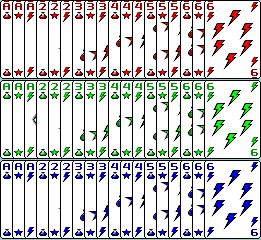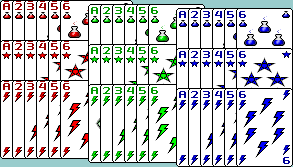

TRIPLICARD™ playing cards and games
New cards. Better games.
TRIPLICARD Elements
TRIPLICARD playing cards - TRIPLICARDS - are made up of three basic elements: suit, color, and rank.
Suits
Unlike a conventional deck of cards, a TRIPLICARD deck contains only three suits: Sciences, Spells, and Storms.

- The suit of Sciences is represented by icons in the form of laboratory beakers.

- The suit of Spells is represented by icons in the form of pentacles (five-pointed stars).

- The suit of Storms is represented by icons in the form of stylized thunderbolts.
In each suit of the common pack are 18 cards: six Red (A, 2, 3, 4, 5, 6), six Green (A, 2, 3, 4, 5, 6), and six Blue (A, 2, 3, 4, 5, 6). The standard deck adds one Noble to each suit.
None of the Royals belongs to a specific suit. However, in some games (e.g., Pokingo or Simplex) the Grand and Suit Royals can match any suit, and in trump games all three Royals act as ex officio members of the trump suit, if there is one.
Color
TRIPLICARDS come in three distinguishing colors (Red, Green, and Blue), not just two, but the differences only start there. In a conventional pack of playing cards, color is merely a slave of suit: some suits are red, some black - and interbreeding is strictly forbidden. (Very 18th Century.) In a modern TRIPLICARD deck, color and suit are completely independent: each color includes cards of each suit - and vice versa, naturally.
In a conventional pack of playing cards, color is merely a slave of suit: some suits are red, some black - and interbreeding is strictly forbidden. (Very 18th Century.) In a modern TRIPLICARD deck, color and suit are completely independent: each color includes cards of each suit - and vice versa, naturally.
In the common pack (shown here), each color group contains 18 cards: six Sciences, six Spells, and six Storms. The standard deck also includes one Noble in each color.
No Royal is Red, Blue, or Green. However, in some games (e.g., Pokingo or Simplex) the Grand and Color Royals can match any color, and in certain trump games (e.g., Triumph or 501) all three Royals act as ex officio members of the trump color, if there is one.
No TRIPLICARD deck contains a black suit or color group. Instead, black is a common or neutral color that may indicate the absence of color affiliation.
Rank
Like an ordinary playing card, a TRIPLICARD's rank - its number or value - is indicated by a letter or number in the card's upper left and lower right corners. In the common pack, there are only six ranks: Ace [A], Two [2], Three [3], Four [4], Five [5], and Six [6]. In all games played with this deck - which includes most solitaires (e.g., Eureka) and discarding games (e.g., Stop & Go) - Sixes are high and Aces low.
The standard deck includes two additional ranks: Nobles and Royals. Such court cards (akin to face cards and jokers) always outrank common cards (even Aces!), and Royals are nominally higher than Nobles. In games related to Poker - even a family game like Pokingo, which uses the equivalent of Poker hands for scoring - Royals are high, and Aces are low. In counting games (like Fifteen or Simplex), all court cards share the same numeric value - usually seven - while an Ace (again low) is treated as a One. Only in trump and no-trump games, like Grab and Heartless, are Aces elevated, so that cards rank Royal [R] (high), Noble [N], Ace [A], Six [6], Five [5], Four [4], Three [3], Two [2] (low).
Confused? Don't be. Court cards (if used) are always high, and Royals are generally highest. Aces are typically low, except in one group of games (the cousins of Hearts, Spades, Bridge, and 500), in which they outrank all other common cards - but no court cards.
 Although a conventional deck has four cards of each rank, there are nine common cards of each rank in most TRIPLICARD decks: three in each suit, three in each color, and one in each family. The accompanying illustration shows nine Aces, but the arrangement of suit and color is the same for all common cards. On the other hand, court cards come in threes (not nines): even in the standard deck, there are only three Royals and three Nobles.
Although a conventional deck has four cards of each rank, there are nine common cards of each rank in most TRIPLICARD decks: three in each suit, three in each color, and one in each family. The accompanying illustration shows nine Aces, but the arrangement of suit and color is the same for all common cards. On the other hand, court cards come in threes (not nines): even in the standard deck, there are only three Royals and three Nobles.
Note that the abridged compact deck includes the same ranks as the standard deck; however, it contains fewer common cards in each suit (12), color (12), rank (six), and family (four). Other TRIPLICARD decks may contain additional ranks of common cards (e.g., 7s, 8s, and 9s), court cards, or both.
Families
 In a TRIPLICARD deck, each of the nine different combinations of suit and color (Blue Sciences, Red Sciences, Red Storms, etc.) is called a family. In the common pack (shown here with its cards grouped in families), there are six cards (one of each rank) in each family. In the standard deck, three families - Red Sciences, Green Spells, and Blue Storms - contain seven cards each: six common cards and one Noble.
In a TRIPLICARD deck, each of the nine different combinations of suit and color (Blue Sciences, Red Sciences, Red Storms, etc.) is called a family. In the common pack (shown here with its cards grouped in families), there are six cards (one of each rank) in each family. In the standard deck, three families - Red Sciences, Green Spells, and Blue Storms - contain seven cards each: six common cards and one Noble.
Since Royals are not members of any specific suit or color, they do not belong to a particular family, either. However, in some games (e.g., Pokingo) the Grand Royal can act like a member of any family you want to match.
Related Pages: For further information, use the links below.
HOME | LEGAL | PRIVACY | CONTACT | TOP
©2002 Free Fall Games. All rights reserved.